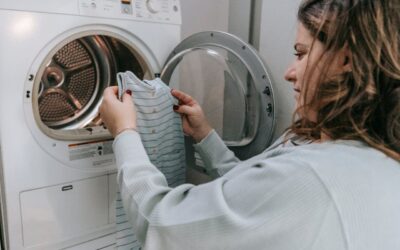Knowing the differences between washing and dry cleaning is essential for maintaining the quality and longevity of your clothes. While both methods are used to clean garments, they involve different processes and are suitable for different types of fabrics. By understanding the pros and cons of each method, as well as the types of fabrics that require dry cleaning or can be washed, you can make informed decisions about how to care for your clothes.
Key Takeaways
- Washing and dry cleaning are two different methods of cleaning clothes.
- Pros of washing include convenience and cost-effectiveness, while cons include potential damage to certain fabrics and less effective stain removal.
- Pros of dry cleaning include effective stain removal and preservation of delicate fabrics, while cons include higher cost and potential exposure to chemicals.
- Fabrics that require dry cleaning include silk, wool, and leather, while fabrics that can be washed include cotton, polyester, and denim.
- Factors to consider when deciding between washing and dry cleaning include fabric type, level of dirt or stains, and care instructions on the garment label.
Understanding the Differences Between Washing and Dry Cleaning
Washing is a common method of cleaning clothes that involves using water, detergent, and mechanical agitation to remove dirt and stains. It is suitable for most everyday fabrics, such as cotton, polyester, and denim. The process typically involves sorting clothes by color and fabric type, pre-treating stains, selecting the appropriate wash cycle and temperature, and drying the clothes afterwards.
Dry cleaning, on the other hand, is a specialized cleaning method that uses chemical solvents instead of water to clean clothes. It is particularly effective for delicate fabrics that cannot withstand the harsh conditions of a washing machine. The process involves placing the clothes in a machine that agitates them with the solvent, followed by a drying process that removes any remaining solvent.
Pros and Cons of Washing Your Clothes
There are several advantages to washing your clothes. Firstly, it is a convenient and cost-effective method that can be done at home using a washing machine. Secondly, washing clothes with water and detergent can effectively remove dirt, stains, and odors. Additionally, washing clothes regularly can help maintain their color and shape over time.
However, there are also some disadvantages to washing clothes. Certain fabrics may shrink or become damaged when exposed to water and agitation. Delicate items with intricate details or embellishments may also be prone to damage in a washing machine. Furthermore, some stains may be difficult to remove through washing alone, requiring additional treatments or professional cleaning.
Pros and Cons of Dry Cleaning Your Clothes
| Pros of Dry Cleaning | Cons of Dry Cleaning |
|---|---|
| Removes tough stains and odors | Can be expensive |
| Preserves the quality of delicate fabrics | Chemicals used in dry cleaning can be harmful to the environment |
| Convenient for busy individuals | May not be as effective as washing clothes at home |
| Can save time and effort | May cause damage to certain types of fabrics |
Dry cleaning offers several advantages for certain types of fabrics. Firstly, it is a gentle cleaning method that does not involve water or mechanical agitation, making it suitable for delicate fabrics such as silk, wool, and cashmere. Secondly, dry cleaning can effectively remove tough stains and odors that may not be easily removed through washing. Additionally, dry cleaning can help preserve the color, shape, and texture of garments.
However, there are also some disadvantages to dry cleaning clothes. Firstly, it can be more expensive than washing, as it requires specialized equipment and solvents. Secondly, the chemicals used in dry cleaning can be harsh and may cause damage to certain fabrics over time. Furthermore, the process of dry cleaning can take longer than washing, as the clothes need to be dropped off at a dry cleaner and picked up at a later time.
Types of Fabrics That Require Dry Cleaning
Certain types of fabrics require dry cleaning due to their delicate nature or specific care instructions. These fabrics include silk, wool, cashmere, velvet, suede, and leather. Silk is a delicate fabric that can easily be damaged by water and agitation. Wool and cashmere are prone to shrinking and losing their shape when exposed to water. Velvet can become crushed or lose its luster when washed. Suede and leather require specialized cleaning methods to maintain their texture and appearance.
These fabrics require dry cleaning because the chemical solvents used in the process are gentle enough to clean them without causing damage. Dry cleaning also helps preserve the natural properties of these fabrics, such as their softness, sheen, and texture.
Types of Fabrics That Can Be Washed
While some fabrics require dry cleaning, there are many others that can be safely washed at home. These include cotton, polyester, denim, linen, nylon, and acrylic. Cotton is a durable fabric that can withstand regular washing without losing its shape or color. Polyester is a synthetic fabric that is resistant to shrinking and wrinkling, making it suitable for machine washing. Denim is a sturdy fabric that can be washed to maintain its texture and fade over time. Linen, nylon, and acrylic are also fabrics that can be safely washed without causing damage.
These fabrics can be washed because they are more durable and can withstand the water and agitation involved in the washing process. They also do not require the specialized care that delicate fabrics do.
How to Determine Whether to Wash or Dry Clean Your Clothes
When deciding between washing and dry cleaning your clothes, there are several factors to consider. Firstly, check the care label on the garment for specific instructions. The care label will indicate whether the garment should be washed or dry cleaned, as well as any special considerations or precautions. Secondly, consider the fabric type and its sensitivity to water and agitation. Delicate fabrics such as silk, wool, and cashmere should be dry cleaned to avoid damage. Lastly, consider the type of stain or odor you are trying to remove. Some stains may require professional cleaning or additional treatments that cannot be achieved through washing alone.
To make the right choice, it is important to follow the care instructions provided by the manufacturer and consider the specific needs of each garment. If in doubt, it is always safer to err on the side of caution and opt for dry cleaning.
Tips for Washing Your Clothes
When washing your clothes, there are several guidelines to follow to ensure they are cleaned effectively and maintain their quality. Firstly, sort your clothes by color and fabric type to prevent color bleeding or damage. Secondly, pre-treat stains with a stain remover or detergent before washing. This will help loosen and remove tough stains. Thirdly, select the appropriate wash cycle and temperature for each garment. Delicate fabrics may require a gentle cycle with cold water, while heavily soiled items may need a longer and hotter cycle. Lastly, avoid overloading the washing machine to allow for proper agitation and rinsing.
Dos of washing clothes include using the right amount of detergent, following the care instructions on the garment, and using a gentle detergent for delicate fabrics. Don’ts of washing clothes include using bleach on colored fabrics, washing delicate items with heavy or abrasive fabrics, and drying clothes on high heat.
Tips for Dry Cleaning Your Clothes
When dry cleaning your clothes, there are several guidelines to follow to ensure they are cleaned effectively and safely. Firstly, choose a reputable dry cleaner that has experience with the specific type of fabric you are cleaning. Secondly, inspect the garment for any stains or damage before dropping it off at the dry cleaner. This will help ensure that any necessary treatments or repairs are addressed. Thirdly, communicate any specific concerns or instructions to the dry cleaner, such as removing a particular stain or preserving the shape of a garment.
Dos of dry cleaning clothes include inspecting garments before dropping them off, communicating specific instructions to the dry cleaner, and storing dry cleaned clothes properly to maintain their quality. Don’ts of dry cleaning clothes include attempting to clean delicate fabrics at home, using harsh chemicals on sensitive fabrics, and storing dry cleaned clothes in plastic bags.
How to Care for Your Clothes After Washing or Dry Cleaning
After washing or dry cleaning your clothes, it is important to take steps to maintain their quality and prolong their lifespan. Firstly, hang or lay flat to dry instead of using a dryer whenever possible. This will help prevent shrinkage and maintain the shape of the garment. Secondly, iron or steam your clothes to remove wrinkles and creases. Use the appropriate heat setting for each fabric to avoid damage. Thirdly, store your clothes in a cool, dry place away from direct sunlight to prevent fading and discoloration.
It is also important to follow any additional care instructions provided by the manufacturer, such as avoiding exposure to certain chemicals or avoiding excessive heat. By taking proper care of your clothes after washing or dry cleaning, you can ensure that they continue to look and feel their best.
Making the Right Choice: Factors to Consider When Deciding Between Washing and Dry Cleaning
To make the right choice between washing and dry cleaning, it is important to consider several factors. Firstly, check the care label on the garment for specific instructions. This will provide guidance on whether the garment should be washed or dry cleaned. Secondly, consider the fabric type and its sensitivity to water and agitation. Delicate fabrics such as silk, wool, and cashmere should be dry cleaned to avoid damage. Thirdly, consider the type of stain or odor you are trying to remove. Some stains may require professional cleaning or additional treatments that cannot be achieved through washing alone.
Other factors to consider include the cost and convenience of each method. Washing clothes at home is generally more cost-effective and convenient, while dry cleaning may be more expensive and time-consuming. Additionally, consider the overall condition of the garment and its value. If a garment is particularly valuable or sentimental, it may be worth investing in professional dry cleaning to ensure its preservation.
In conclusion, knowing the differences between washing and dry cleaning is essential for maintaining the quality and longevity of your clothes. By understanding the pros and cons of each method, as well as the types of fabrics that require dry cleaning or can be washed, you can make informed decisions about how to care for your clothes. Whether you choose to wash or dry clean your clothes, following proper guidelines and care instructions will help ensure that your garments continue to look their best for years to come.
We would love to hear about your experiences with washing and dry cleaning clothes. Share your thoughts and tips in the comments below!
If you’re trying to decide between washing or dry cleaning your clothes, it’s important to consider the benefits of each method. While washing may seem like the more convenient option, there are certain garments that require the expertise of a professional dry cleaner. In fact, a recent article on Simply Search discusses 15 reasons why hiring professional dry cleaner services is worth it. From delicate fabrics to stubborn stains, professional dry cleaners have the knowledge and equipment to handle a wide range of clothing care needs. To learn more about the advantages of professional dry cleaning, check out the article here.
FAQs
What is washing?
Washing is a process of cleaning clothes using water, detergent, and mechanical action to remove dirt and stains.
What is dry cleaning?
Dry cleaning is a process of cleaning clothes using a chemical solvent instead of water to remove dirt and stains.
What are the advantages of washing?
Washing is a cheaper and more convenient option for cleaning clothes. It is also effective in removing water-soluble stains and odors.
What are the disadvantages of washing?
Washing can damage delicate fabrics and cause shrinkage. It may not be effective in removing oil-based stains and may require multiple washes to remove tough stains.
What are the advantages of dry cleaning?
Dry cleaning is effective in removing oil-based stains and does not cause shrinkage or damage to delicate fabrics. It also provides a professional finish to clothes.
What are the disadvantages of dry cleaning?
Dry cleaning is more expensive than washing and may not be as convenient. It also uses chemical solvents that can be harmful to the environment and may cause allergic reactions in some people.
How do I determine which is better for my clothes?
The best way to determine which method is better for your clothes is to check the care label. Clothes that are labeled “dry clean only” should be taken to a professional dry cleaner. Clothes that are labeled “machine washable” can be washed at home. If you are unsure, it is best to err on the side of caution and take your clothes to a professional cleaner.




